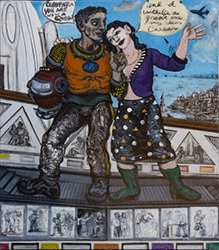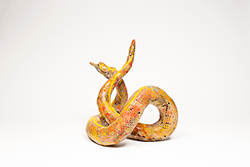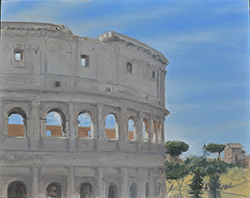Milo Reice
The Caesar Paintings & Other Works
Images
Marc Trujillo
Roman Plein Air
Images
December 5, 2023 - January 30, 2021
Open House: Saturday, December 5, 1-5 PM
Masks and social distancing are required
10 visitors maximum in the gallery at any given time
Appointments are not required. If you wish to reserve a specific time,
email us at info@craigkrullgallery.com
Milo Reice considers himself a classicist in the same vein as Picasso, a Modernist with classical sensibilities and a deeply engrained reverence for Greco-Roman history and forms. He grew up three blocks from The Met, visiting its glorious halls weekly, while Abstract Expressionism and Pop Art were flowing through the streets of New York.
He became what one would call a narrative painter, telling stories that draw parallels between the past and the present. Reice revels in process, making drawings, sketches and studies as improvisational groundwork for his grand, operatic large-scale paintings. He often incorporates these studies into the finished painting by positioning them in a row along the bottom, similar to the predella of Renaissance altarpieces. The Caesar Paintings and Other Works is his first solo exhibition at Craig Krull Gallery. The Caesar Quintet reimagines the assassination of Julius Caesar as an analog for current events in the American political scene. Unlike many contemporary thinkpieces, however, Reice envisions Caesar as a symbol of the federal government as a whole. Brutus and the assassins are cast as those whom he believes are stepping upon our democracy.
Gwynn Murrill is widely recognized for her sleek and streamlined bronze sculptures of cats, coyotes and birds, which she describes as “simultaneously abstract and figurative.” In contrast, her exhibition, Serpientes consists of the unique, hand-built and sometimes ruggedly composed twisty coils of ceramic snakes. Serpents have historically played key symbolic roles, from the Garden of Eden to the legendary bite of the asp on Cleopatra’s neck. Not coincidentally, they also appear in many of Milo Reice’s biblical paintings. Our collective response to this creature is like that of no other. Emily Dickinson’s poem “A narrow Fellow in the Grass” captures the instant fear upon seeing a snake: she writes, “[I] never met this Fellow / Attended or alone / Without a tighter Breathing / And Zero at the Bone.” Murrill works to counter our instinctive reaction by depicting snakes “as they see themselves” and lavishing them with painterly decorations and brilliant colors.
Marc Trujillo describes his chosen subject as “the purgatory of American urban and suburban landscapes.” They are actually the everyday locales of giant warehouse shopping and fast food chains, but the oddly antiseptic and brutally cold realism of these works are chilly reminders of our contemporary robotic existentialism. Trujillo, like Milo Reice, is cognizant of our place on the timeline of history, and equally sees the parallels and contrasts of Los Angeles and Ancient Rome. The paintings in his exhibition Roman Plein Airs have been crafted over several years of trips to the Eternal City, where he teaches a course each summer. His series of intimate, fresh paintings of classic Rome may perhaps frame our current culture in Ozymandian perspectives, but they are, more simply, a beautiful expression of that long and inexhaustible tradition of plein-air painting that found artists like Corot on the banks of the Tiber painting those same views.
Gwynn Murrill is widely recognized for her sleek and streamlined bronze sculptures of cats, coyotes and birds, which she describes as “simultaneously abstract and figurative.” In contrast, her exhibition, Serpientes consists of the unique, hand-built and sometimes ruggedly composed twisty coils of ceramic snakes. Serpents have historically played key symbolic roles, from the Garden of Eden to the legendary bite of the asp on Cleopatra’s neck. Not coincidentally, they also appear in many of Milo Reice’s biblical paintings. Our collective response to this creature is like that of no other. Emily Dickinson’s poem “A narrow Fellow in the Grass” captures the instant fear upon seeing a snake: she writes, “[I] never met this Fellow / Attended or alone / Without a tighter Breathing / And Zero at the Bone.” Murrill works to counter our instinctive reaction by depicting snakes “as they see themselves” and lavishing them with painterly decorations and brilliant colors.
Marc Trujillo describes his chosen subject as “the purgatory of American urban and suburban landscapes.” They are actually the everyday locales of giant warehouse shopping and fast food chains, but the oddly antiseptic and brutally cold realism of these works are chilly reminders of our contemporary robotic existentialism. Trujillo, like Milo Reice, is cognizant of our place on the timeline of history, and equally sees the parallels and contrasts of Los Angeles and Ancient Rome. The paintings in his exhibition Roman Plein Airs have been crafted over several years of trips to the Eternal City, where he teaches a course each summer. His series of intimate, fresh paintings of classic Rome may perhaps frame our current culture in Ozymandian perspectives, but they are, more simply, a beautiful expression of that long and inexhaustible tradition of plein-air painting that found artists like Corot on the banks of the Tiber painting those same views.


